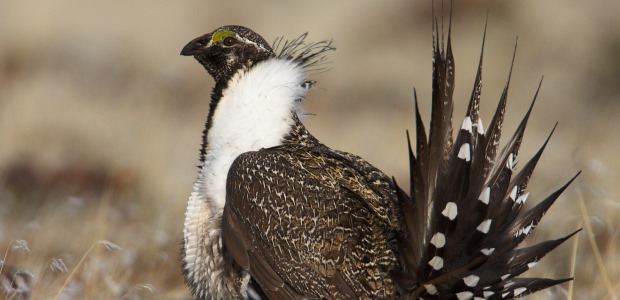
NWF Sportsmen's Poll Supports Sage Grouse Conservation
A poll of 1,335 sportsmen and women in 11 states in the heart of greater sage-grouse country showed a majority support restrictions in important habitat to save the bird and avoid its placement on the federal Endangered Species List.
The National Wildlife Federation on Nov. 19 released results from a poll of sportsmen and women in 11 states in the heart of greater sage-grouse country, with a majority of the respondents supporting efforts to protect the bird and the sagebrush landscape that supports it. A majority backed restrictions in important habitat to save the bird and avoid its placement on the federal Endangered Species List. Such a listing probably would lead to more stringent, long-term constraints on activities as hunting, fishing, recreation, and grazing, said John Gale, NWF's national sportsmen's campaign manager.
"First and foremost, it's critical that we save this iconic Western wildlife species," he said. "We can do that with strong conservation plans that protect key greater sage-grouse habitat while allowing responsible energy development, grazing, and other activities on other public lands."
He pointed to the U.S. Fish and Wildlife Service announcement last week that it is classifying the Gunnison sage-grouse as threatened to keep it from going extinct. The Gunnison sage grouse is smaller than the greater sage-grouse and now is found in portions of Colorado and southeastern Utah, which represent only 7 percent of its historic range, according to NWF.
"If we are to prevent the listing of the sage grouse under the Endangered Species Act, we must engage in collaborative implementation strategies that will lead to population increases throughout the bird's range," said Ed Arnett, director of the Theodore Roosevelt Conservation Partnership Center for Responsible Energy Development. "More than 350 species of plants and animals rely on healthy sagebrush habitat. The greater sage-grouse is the canary in this particular coal mine, and how we deal with it will affect an entire ecosystem."
Conducted by Southwick Associates for NWF, the poll surveyed 1,335 randomly selected sportsmen and women in Montana, Colorado, Nevada, North Dakota, South Dakota, Utah, Wyoming, Washington, Oregon, northern California, and Idaho. Its margin of error is 2.7 percent. Among the results from the survey of 1,335 hunters between Sept. 23 and Oct. 3 are these:
- Nine out of 10 hunters believe it is important to take action to protect sage-grouse habitat within their state, and 84 percent of hunters support steps by the Bureau of Land Management (BLM) to protect critical sage-grouse habitat even if it means limiting energy development, grazing rights, or access for motorized recreation on those lands.
- Hunters generally link protection of sage-grouse habitat with maintaining healthy populations of other wildlife species.
- Nearly 79 percent of the respondents had fished or hunted on public land in their state within the past year.
Land Tawney, executive director of Backcountry Hunters & Anglers, said because most of the greater sage-grouse's habitat is on public lands, BLM and states where the bird is found must step up now. "It's not just about the bird; it's about the herds of mule deer and pronghorns, the hunting and other recreation made possible by healthy habitat," Tawney said.
NWF said the survey followed a recent report showing that almost none of the important greater sage-grouse habitat is currently home to any energy production and that 73 to 81 percent of areas with medium to high potential for energy development are outside the bird's habitat.